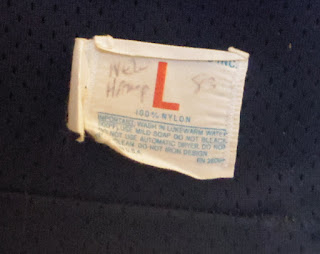With Maine and UNH set to open the season against each other this week (and boy, is that strange to type after all those years of the Bears and Cats facing off in the finale), let's take a look at the "classic" New Hampshire uniform of yore, something we started doing in an earlier post.
The uniform, which made its debut in 1976, saw its sleeve stripes tweaked in '78 to create a style that went virtually unchanged for more than two decades. If you were even a casual Granite State sports fan in the 1980s or '90s, you're familiar with this uniform. The while "NH" helmet is to fans from that era as the silver lid with the "UNH" wildcat in profile is to the current generation.
 |
| Wildcats are scurrying everywhere in the 1979 picture from the Granite yearbook. Watch out, ref! |
 |
| The coin toss at Cowell Stadium, 1981. |
The only changes were minor: The "NH" helmet logo was enlarged in '84; the facemask went blue in '85; and Champion-made home jerseys were phased out for Wilson models in the mid-90s. The names on the back, as early as the mid-80s, showed some inconsistency with the fonts.
 |
| UNH takes on Northeastern, 1983. So many generations of fans have watched the games from that bank over the years ... |
 |
| A pair of old UNH media guides. Sadly, they're not mine. |
The big oddity comes in the road models, which followed the same template as the homes, but the numbers eschewed the Champion font (curved 7s and diagonal 2s) for a blockier font, indicating they likely were made by someone else. (This continued even to the final days of this style, when Wilson made the homes and Russell made the roads.) This was not uncommon in baseball (According to William Henderson's exhaustive Game Worn Guide to MLB Jerseys, many hardball teams decades ago used different manufacturers for home and road jerseys), but it seems odd a I-AA/FCS team would do the same thing. The roads also had no manes on the back, unlike the homes -- right up until 2000, the last year these jerseys were worn.
 |
| The 1979 UNH road jersey, with the blocker 2s. BTW, the single-season field goal record is now 18. |
And since I have one of these bad boys in my collection, let's do an "Inside the Jersey," shall we?
The Jersey: New Hampshire, 1983, as evidenced by the "NEW HAMP 83" on the tag.
 |
| The "NEW HAMP 83" is scrawled on the tag, showing it's a New Hampshire jersey. Or maybe it's New Hampton prep school in upstate New Hampshire? But their colors are green and black, so I'm guessing no. |
How It Was Acquired: eBay, about $30. A virtual steal.
Who Wore It: In the words of Allen Ludden on Password Plus, "I haven't the foggiest." But future Steelers fullback and Super Bowl champion Dan Kreider wore No. 44 for UNH in the late 90s.
Who Made It: Champion, as discussed earlier.
Size: A very roomy L. One thing I've discovered in my uniform research/collecting is that not everyone used numbered sizes.
Design: See above.
Condition: Definitely shows some game use, especially on the left sleeve, which shows signs of surgery. I'm guessing this was recycled for the next season or two. The back shows evidence that the name has been removed.
 |
| Yup, this one's been through a few wars. |
Final Verdict: I'm a Maine guy through and through, but it's still super-cool to own such a historic jersey from a historic program.
There are plenty more Wildcat uniforms where this came from: 2015, 2014, 2010-13, 2000, 1998, 1975, 1968-71 (part 1) (part 2), 1966-67, 1965 1955, 1950, 1947-48, 1938, 1936. Rivalry Week: Maine-UNH.







































